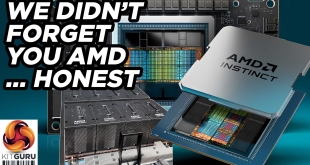Terry Makedon really needs no introduction, as the ‘Catalyst Maker' he has been one of AMD's high profile celebrities now for many years, interacting with the public on many technology forums and running a hugely popular Twitter feed with almost 10,000 followers.
Terry was recently over in Ireland with some of his colleagues and we ended up sharing an evening of fine Italian food, good red wine and then later some blues guitar with Eric Clapton.
The thing I have always liked about Terry is that he is good fun. He can turn the ‘tech talk' off and enjoy himself, having so many interests outside AMD. We share the same love of classic rock and guitar players, so keeping the conversation on track just for technology can sometimes be difficult.

As Catalyst Maker Terry has always been active on the forums, helping AMD customers with their problems and often taking onboard feedback for future product development. Many people have been asking me recently how Terry's job within AMD has changed, since he moved teams to join Fusion . Between chats about guitar players I asked him why he decided the time was right for a move. Terry now handles the product marketing for Catalyst (Vision Engine Software) for the all in one APU range of products.
“After 9 years and 11 months of working on GPU software I decided to accept a fresh challenge and work on the new and exciting area of APU software. It really isn’t that much of a drastic change for me, essentially I am now the manager of software marketing for our APU’s. As we really pick up steam on these products we thought it would be a good idea to bring some of the great ideas and lessons learned on Catalyst into the APU space.”
I mentioned to Terry that APU's are certainly a significant part of the current roadmap for AMD and that our reviews of the systems so far certainly indicate a healthy future. (check some of them out here, here and here). The Hewlett Packard DM1Z however is my personal favourite.
Terry said that many people didn't really understand what an ‘APU' was, and tried to break it down into a single sentence for our readers:
“Imagine a processor that has both the CPU and discrete level DX11 class GPU functions in it and you have an APU. I recommend a look at this youtube video for a nice visual of it”
The subject then progressed to the software side of Fusion and Terry said that AMD's support for the platform is a key priority “We we will continue with updates 12 times a year, always Microsoft certified as well as continuing to deliver some combination of performance improvements, stability improvements and innovative new features.”
I mentioned that Intel have recently announced the availability of their OpenCL beta SDK and I asked him what he thought about it.
“I am thrilled that other companies like us are supporting industry standards. As an industry we need to remove the barriers presented by hardware specific proprietary development environments. Not only is it unfair to expect software developers to code their applications to only work on only a subset of hardware, it is even more unfair to expect consumers to have to try and match their hardware purchases with software for them to enjoy maximum performance.
I have personally been saying for many years now that the PC industry must be based on industry standards and am very happy to see others actions back up that view point. For our Fusion APU’s, a healthy OpenCL ecosystem is very important because application performance will be maximized by processing on the CPU or the GPU functional areas as needed. For anyone interested in more information on our SDK please refer to our website here http://developer.amd.com/gpu/AMDAPPSDK/Pages/default.aspx”
While touching on the subject, I asked him how AMD were supporting developers who wanted to take advantage of OpenCL and Application Acceleration. ”
Our inaugural Fusion Developer Summit is around the corner. We refer to it as Fusion ’11, and it is being held in the Seattle area June 13-16. I urge any developers to join us and be part of the growing developer community that supports OpenCL based development. To register or read more about it check this out www.amd.com/afds
Terry then brought up the point that Catalyst Control Center has been renamed on some systems to ‘Vision Engine Software'.
“We will call the discrete level graphics functionality found in the APU’s (primarily the Radeon Cores and the Video Accelerator) the Vision Engine. To make the AMD Vision Engine work you of course need drivers and supporting software. Thus we decided to start calling the software itself the Vision Engine Software. Essentially we are defining the AMD Vision Engine the “black box” in the APU that enables the amazing DX11 class graphics.
On all AMD based systems CCC has been renamed Vision Engine Control Center. CCC is still a valid name for GPU’s running on competitor CPU’s.
You will hear a lot more about AMD Vision Engine and AMD Vision Engine Software in the next few months.”
As always, spending time with Terry was great fun and we will have more coverage of Fusion coming up shortly on KitGuru, but this particular interview was cut short, because we had a date with blues legend Eric Clapton.
 KitGuru KitGuru.net – Tech News | Hardware News | Hardware Reviews | IOS | Mobile | Gaming | Graphics Cards
KitGuru KitGuru.net – Tech News | Hardware News | Hardware Reviews | IOS | Mobile | Gaming | Graphics Cards


